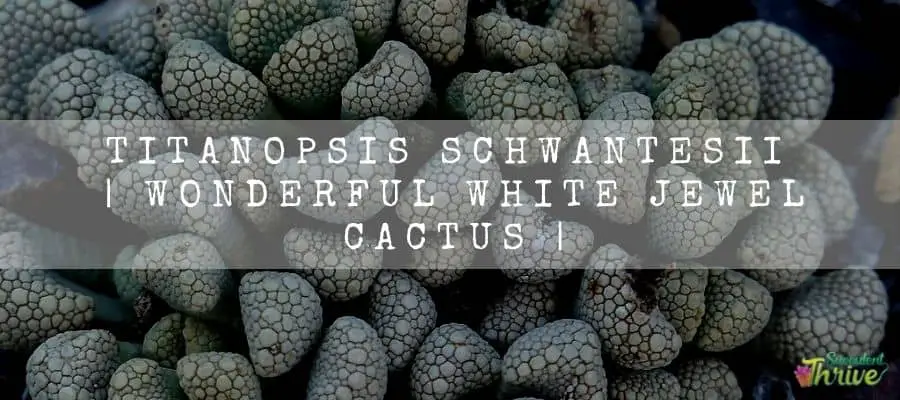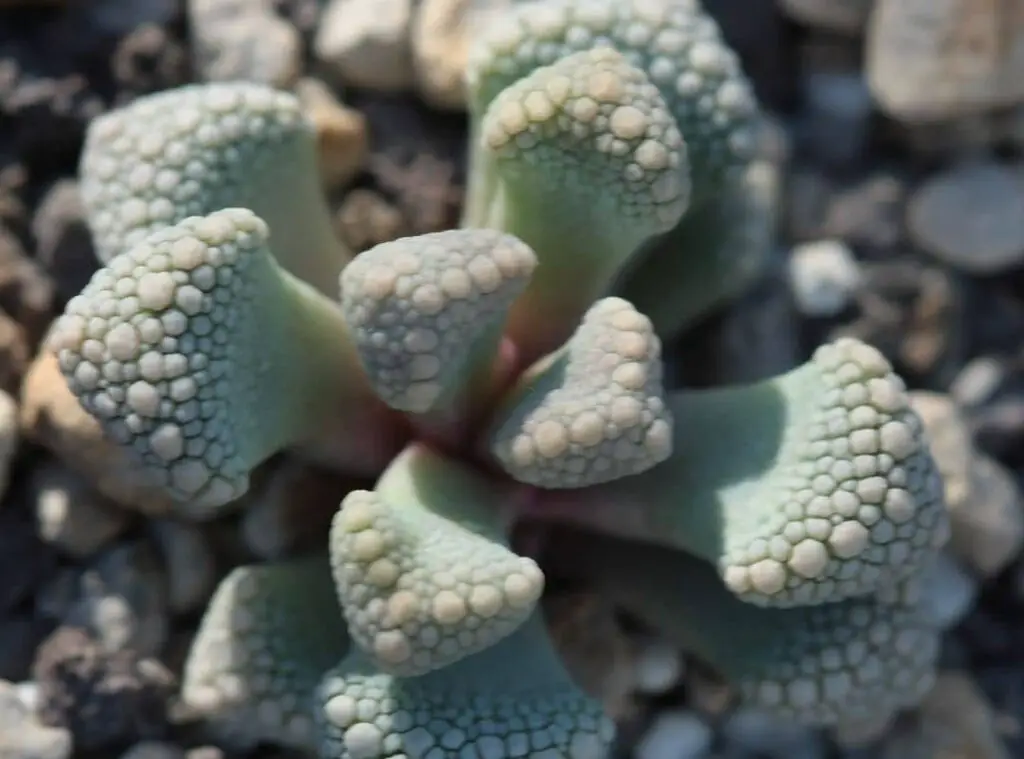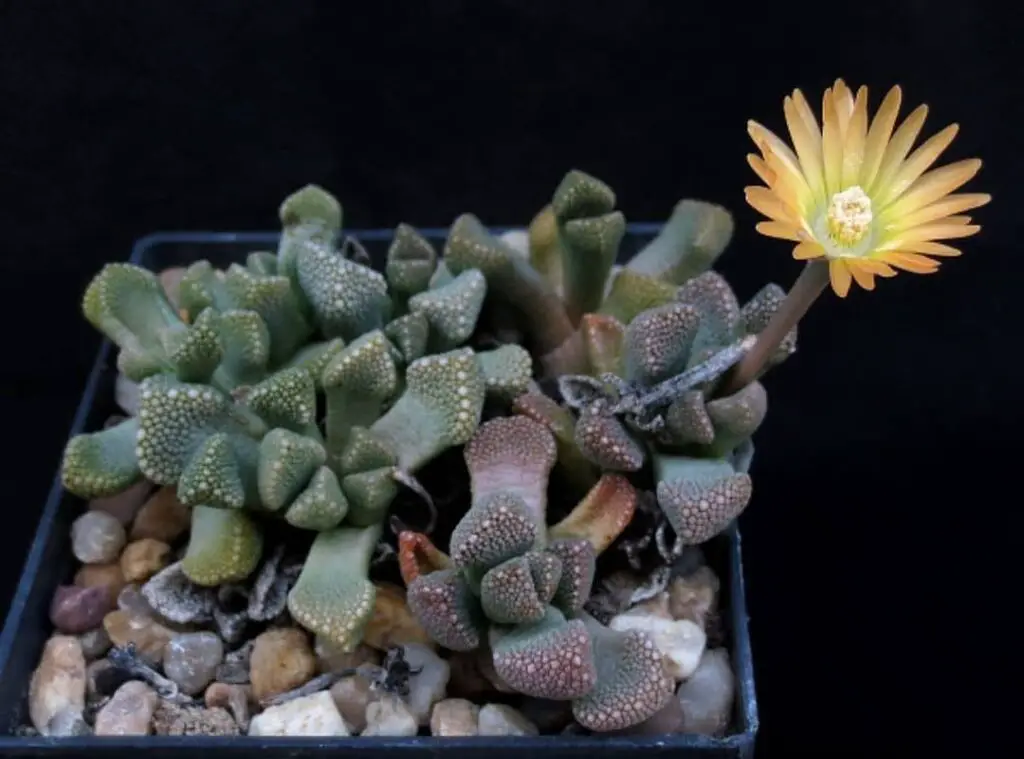Titanopsis schwantesii are yet another fabulous succulents which you may come across in the succulent and the cactus world.
They go by the name white jewel plant. These are native plants in Southern Namibia.
They are clump forming plants and the highlight of these plants is their grayish blue leaves.
If you are excited to discover these plants, keep reading this article as I am going to cover the right growing conditions you need to practice when looking after them and the propagation methods etc.

How do I identify Titanopsis schwantesii?
They have grayish blue leaves and those leaves carry red tips. You could identify the plants from those characteristics.
They have their own unique appearance, and they have a close resemblance to rocks. The Titanopsis schwantesii leaves form in small rosettes and they would consist of warty tubercles.
They have leaves forming in an erecting manner. Their stem could go unnoticed.
Titanopsis schwantesii rosettes are 5 cm in width. Moreover, each rosette would consist of about 6-8 oppositely formed leaves.
The leaves are short and fleshy. You could spot the Titanopsis schwantesii leaves, upper and lower surfaces forming in gray-white warts.
Additionally, chances are that they may form in yellow, gray-brown, or yellow-brown colors as well. Their bloom with attractive, yellow-colored flowers from fall to early fall.
Size of the plant
The rosettes would be 5 cm in width.
Growth rate
They are slow growers.
One look care guide
| Botanical Name | Titanopsis schwantesii |
| Common Name | White jewel plant |
| Plant Type | Cactus |
| Mature Size | Rosettes would be 5 cm in width. |
| Sun Exposure | Full sunlight |
| Soil Type | Well draining |
| Soil pH | pH range of 7.5-8.5 |
| Bloom Time | Early fall or late fall |
| Flower Color | yellow |
| Hardiness Zones | 9b-11b from 25 degrees Fahrenheit ( -3.9 degrees Celsius) 50 degrees Fahrenheit ( 10 degrees Celsius) |
| Native Area | Southern Namibia |
| Toxicity | Not toxic |
| Average price | 8 USD |
How do you take care of Titanopsis schwantesii?
Light Requirement
When it comes to providing the right light levels for the Titanopsis schwantesii, you need to ensure that they get bright sunlight levels.
During winter you can expose them for direct sunlight. Refrain in exposing them for harsh sunlight during intense summer conditions. They would prefer to have full sunlight during winter.

Temperature and humidity.
They prefer to have low humidity levels to perform well. Titanopsis schwantesii are winter growing plants. Hence you need to keep them relatively dry during summer.
Is it cold hardy?
USDA Hardiness Zone
Watering Requirement
Titanopsis schwantesii perform well with minimum watering.
Do not over water them or keep them stranded in waterlogged conditions for too long as it will create unhealthy repercussions on the plants.
You need to water them sparingly during summer whilst ensuring that you do not let them become shriveled.
Watering the Titanopsis schwantesii properly has a greater impact when taking care of them well.
Soil Requirement Type / pH.
Titanopsis schwantesii prefers to have a substrate which has an excellent drainage. Ideally it needs to be a gritty one as well. A ph. range of 7.5-8.5 would suit the Titanopsis schwantesii well.
Pot size Potting and Repotting
You can go ahead with a porous material pot to plant the Titanopsis schwantesii. Additionally the right pot should comprise a draining hole in the bottom of the pot as well.
That will ensure that no excess water is retained in the pot. You do not need to repot the Titanopsis schwantesii quite often as they are slow growing plants.
Flowers.
Titanopsis schwantesii flowers in yellow and they would be 15-18 mm in diameter. You could spot the petals forming two numerous petal whorls. Their blooming season would be fall.

Dormancy
Toxicity
They are not toxic plants.
Common bugs and illnesses
Titanopsis schwantesii are prone towards aphids’ attacks. They are small and contain a body which is soft. These are not the types of pests which move fast.
They instead depend on the plant’s sap. You could spot the aphids forming in numerous colors such as in green, brown, black etc.
They further consist of wings too. Aphids release a sweet substance, and you could call it honeydew. Consequently, it will lead to a sorry mold.
Aphids can multiply faster as they could multiply faster. Literally they can make about 250 nymphs in one months’ time without mating.
You could commonly spot the aphids in spring and in fall. Aphids are quite attractive to yellow . To overcome them, ensure that you keep the surrounding around the plants clean and tidy.
Ensure you remove no weeds around the plants. You can introduce natural predators to remedy them. Besides, you can use organic and inorganic pesticides too.
How to propagate Titanopsis schwantesii
Propagating the Titanopsis schwantesii is an easy process. You can use Titanopsis schwantesii seeds to propagate them. Moreover you can use the division of larger clumps also to propagate them.
Finally
To wind up, Titanopsis schwantesii are such great plants to have and if you ensure that you look after them, they will perform well.
Read Next : Titanopsis Primosii | Amazing Stone-Shaped Succulent | Titanopsis Calcarea | Weird Concrete leaf Succulent Care | Graptoveria Titubans | Amazing Porcelain Plant Care |
